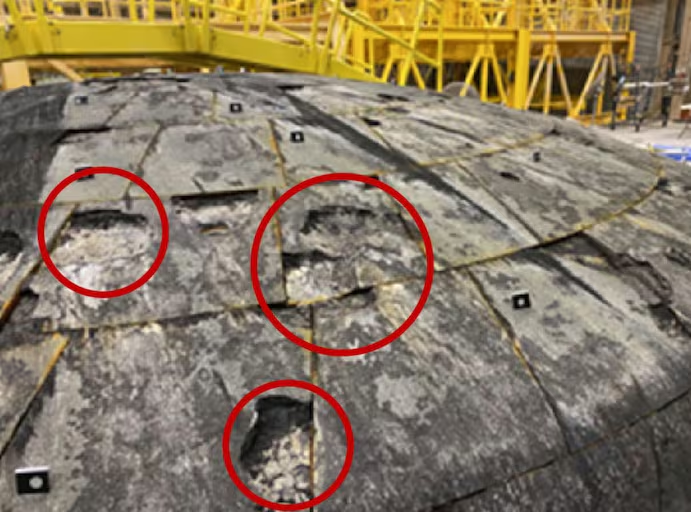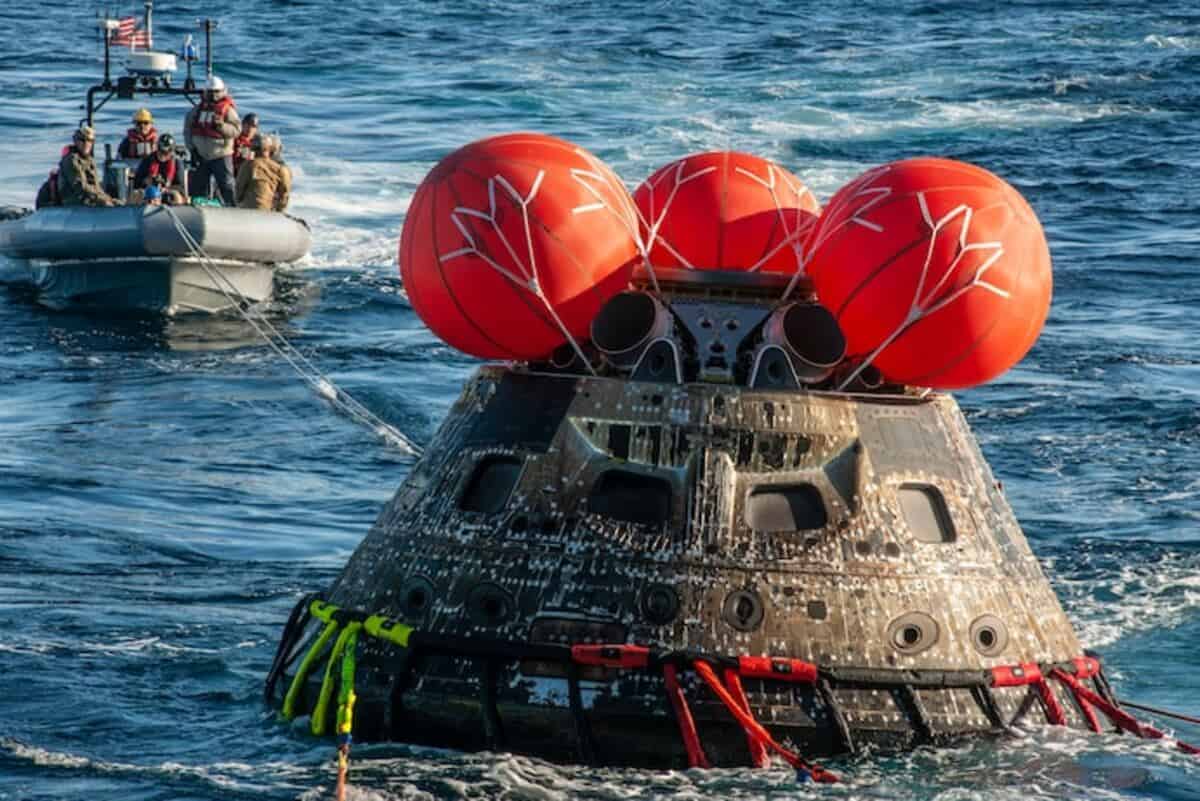All about Artemis
In December 2022, the first mission of the Artemis program returned to Earth, and now a monitoring report has revealed that the Orion spacecraft suffered damage in more than 100 places during its return to the atmosphere. The problems were much greater than NASA engineers had anticipated, raising doubts about whether the program would proceed as expected.
For those in a hurry:
- The monitoring report revealed problems with the heat shield, some of the spacecraft’s bolts, and the launch structure;
- Furthermore, concern has also been expressed that these issues may disrupt the Artemis timeline;
- NASA noted that the tone of the report concerned them, as the issues highlighted were already under discussion.
Problems in Orion
During the return, the capsule encountered temperatures reaching 2,700 degrees Celsius and speeds of 40,000 kilometers per hour. Although it survived, images of its heat shield showed that instead of melting as expected, it actually had grooves that looked like small holes. According to the report, if something similar happens on subsequent Artemis missions, problems could lead to the loss of the vehicle or even the crew.

The report also highlights how spacecraft problems could create challenges for NASA and its timeline for humanity’s return to the Moon. The Artemis 2 mission was initially scheduled for 2024, but the agency earlier this year postponed that to much earlier than September 2025. To understand how heat shield damage occurs.
Although NASA Administrator Bill Nelson recently indicated to a congressional committee that he still believes a human landing on the moon will occur by the end of 2026, the report suggests otherwise. In addition to the heat shield issues, screws on the crew module were exposed, causing greater heating and corrosion than expected.
The monitoring report also noted that the Space Launch System rocket, which took Orion into space, ended up causing problems with ground equipment, such as damage to the elevator in the launch tower. All hull repairs cost NASA about $25 million, when it was expected to cost only $5 million.
Read more:
How NASA received the report
The report relates to statements made by Katherine Koerner, Associate Administrator of the Agency, NASA, in response to… Washington Post, He pointed out that the problems had already been addressed before the report was published.

NASA hoped to discover and solve problems before Artemis 2. The process of finding and addressing engineering challenges is a normal part of the design, test and repair process. NASA is concerned that the tone of the report may suggest that… [Inspetor Geral] It identified the risks discussed, while all recommendations were already being addressed by NASA through risk-based judgment prior to the audit.
Catherine Corner
NASA has assembled a team of investigators to understand how corrosion occurs and why it performs differently than expected. So far, researchers have not reached a conclusion, because it is not possible to recreate the conditions to return to the atmosphere. In addition, engineers are looking for ways to mitigate the loss of coal in the heat shield by modifying its design and planning other Orion reentry paths into the atmosphere.
},
// Lazy:Comments
commentsHidderWidget: function(){
if (!OD._commentsHidderWidget) OD._commentsHidderWidget = OD.e('cmtHiddder');
return OD._commentsHidderWidget;
},
commentsWidget: function(){
if (!OD._commentsWidget) OD._commentsWidget = OD.e('postComments');
return OD._commentsWidget;
},
commentsInit: function(){
var script, head = document.head;
OD.commentsOK = true;
script = document.createElement("script");
script.setAttribute("src", "https://connect.facebook.net/en_US/sdk.js#xfbml=1&version=v2.6");
script.setAttribute("async", "false");
script.setAttribute("onload", "FB.XFBML.parse();");
head.insertBefore(script, head.firstElementChild);
},
// Lazy:openWeb
openWebWidget: function(){
return false;
if (!OD._openWebWidget) OD._openWebWidget = OD.e('widgetOpenWeb');
return OD._openWebWidget;
},
openWebInit: function(){
if (OD.openWebOK === true) return;
OD.openWebOK = true;
// 3rd tag
!function (e, f, u, i) {
if (!document.getElementById(i)){e.async = 1; e.src = u; e.setAttribute('data-spotim-module', 'spotim-launcher'); e.id = i;f.parentNode.insertBefore(e, f);}
}(document.createElement('script'), document.getElementsByTagName('script')[0], '//launcher.spot.im/spot/sp_ScWcqqRz', 'scriptOpenWeb');
if(window.performance && typeof window.performance.mark == 'function') {window.performance.mark('oweb_prfmrk');}
},
// Ajax
getJSON: function(url, data, success, error, complete){
success = success||function(){};
OD.getHTML(url, data, function(responseText){
success(JSON.parse(xhr.responseText));
}, error, complete);
},
getHTML:function(url, data, success, error, complete) {
var xhr = new XMLHttpRequest(),
serialize = function(obj){
var p, str=[];
for (p in obj) {
if (!obj.hasOwnProperty(p)) continue;
str.push(encodeURIComponent(p) + "=" + encodeURIComponent(obj[p]));
}
return str.join("&");
};
xhr.withCredentials = true;
success = success || function() {};
complete = complete || function() {};
error = error || function() {}
xhr.onreadystatechange = function() {
if (xhr.readyState != 4) return;
if (xhr.status == 200) success(xhr.responseText);
else error(xhr.status, xhr.responseText);
complete();
}
xhr.open('GET', url+'&'+serialize(data),true);
xhr.send();
},
// Util
e: function(id){
return document.getElementById(id);
},
isInViewPort: function(element){
var rect, top, bottom;
if (!element) return false;
rect=element.getBoundingClientRect();
top=rect.top;
bottom=rect.bottom;
return (top>=0 && bottom<=window.innerHeight);
},
toggleClass: function(id, className){
var e = OD.e(id);
if (e.classList.contains(className)) {e.classList.remove(className); return false;}
else {e.classList.add(className); return true;}
},
toggleSearch: function(){
if (OD.toggleClass('mainSearch', 'show')) OD.e('mainSearchInput').focus();
},
getUrlParameter: function(name) {
var url = window.location.href.split('?'), vars, upar, i;
url.shift();
vars = unescape(url.join('?')).split('&');
for (i = 0; i < vars.length; i++) {
upar = vars[i].split('=');
if (upar[0] === name) {
if (upar[1] === undefined) return '';
return upar[1].replace(/\+/g, ' ');
}
}
return '';
},
// Resfresh
setupPageRefresh: function(){
var seconds = parseInt(OD.e('body').getAttribute('data-refresh'), 10);
if (seconds<=0) return;
window.setTimeout(function(){location.reload();}, Math.max(30,seconds)*1000);
},
// Behaviors
linkTargetPopup: function(e){
var path=e.path||e.composedPath(), link=false, i, w=600, h=600,l,t,coords="";
if (!path) return;
for (i=0; i
//////////////////////////////////////////////// // OpenWeb //////////////////////////////////////////////// /* window.OD.addOnLoad(function(){ // Apenas matérias if (!OD.postID) return; // Callbacks window.openWeb_onNewUnseen = function(count) { var e = document.getElementById('openWebBellBadge'); if (e){e.innerText = count; e.setAttribute('data-unseen', (count>0 ? 'yes' : 'no'));} } window.openWeb_openNotifications = function(){ var payload = {postId: OD.postID, instanceId: "EmbeddedNotifications"}; if (typeof window.__OW_OPEN_NOTIFICATIONS__ === 'function') { window.__OW_OPEN_NOTIFICATIONS__(payload); window.openWeb_onNewUnseen(0); return; } document.addEventListener('ow-notifications-sdk-ready', function() { window.__OW_OPEN_NOTIFICATIONS__(payload); window.openWeb_onNewUnseen(0); }); // clicked but not loaded, load now if available window.OD.openWebInit(); }; // Init if (typeof window.__OW_SUBSCRIBE_TO_NOTIFICATIONS__ === 'function') { window.__OW_SUBSCRIBE_TO_NOTIFICATIONS__(OD.postID, window.openWeb_onNewUnseen); return; } document.addEventListener('ow-notifications-sdk-ready', function(){ window.__OW_SUBSCRIBE_TO_NOTIFICATIONS__(OD.postID, window.openWeb_onNewUnseen); }); }); */

“Friendly zombie fanatic. Analyst. Coffee buff. Professional music specialist. Communicator.”

/https://i.s3.glbimg.com/v1/AUTH_bc8228b6673f488aa253bbcb03c80ec5/internal_photos/bs/2024/6/v/gdvErAQ3OlW9iQdsQgSg/madonna-getty.jpg)